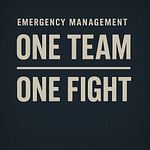Applying Design Thinking to Emergency Management?
I was writing my monolog for one of my podcasts. Prepare, Respond, Recover. I was discussing systems thinking and design thinking in the context of cybersecurity. And it got me thinking, why don't more emergency managers apply design thinking to what they do?
What Steve Jobs Taught Us About Design Thinking…
"Most people mistake thinking design is what it looks like. People think it's this veneer — that the designers are handed this box and told, 'Make it look good!' That's not what we think the design is. It's not just what it looks like and feels like. Design is how it works." Steve Jobs.
A few things stuck with me when I read Steve Jobs by Walter Isaacson. And for the record, I will reread it after writing this piece.
Steve Jobs made an immense impact on the world by putting the user experience (UX) first. His design thinking focused on simplicity and accessibility. In emergency management, we tend to focus on complex problems, and in some cases, I feel that we take something that could be simple and make it complicated. Politics and bad policy make the job much harder. And the user experience from the people we serve and the jurisdiction implementing the policy is unpleasant.
Steve Jobs changed the world of UX through design and his legacy for future generations. He significantly impacted the concept of design thinking thanks to his unrelenting drive to create something new that would change our lives forever. He accomplished this with Apple products like iPhone and iPad and even what we think of what storytelling is by revitalizing Disney's animation division during his time as CEO after buying Pixar from George Lucas.
Designers are often considered to be the most opinionated people on the planet. We're always telling others what they should or shouldn't do with their product, app, website, etc. Steve Jobs was one of those designers that knew precisely what he wanted for his products, and he wasn't afraid to tell you about it. He was a genius with an uncanny ability to understand how humans work.
Steve Jobs was quoted saying, "Design isn't just what it looks like and feels like — design is how it works." This quote speaks volumes about why designing something well doesn't look good. It also means ensuring the user interface is intuitive enough that anyone can use it without much training (or a manual of instructions).
Many people have asked themselves, "what was his design philosophy?"
"People With Passion Can Change The World." Steve Jobs
To understand Steve Jobs' design philosophy, one must first recognize that he had a strong sense of morality and believed strongly in creating simple, easy-to-use, elegant products. He also believed passionately that good design could make a difference in people's lives and contribute positively to society.
Steve Jobs believed that good design was a key component of evolution. And I think that's where we should focus more today; how does design work affect the bigger picture today?
In the field of emergency management, it is more than just putting on exercises and writing plans. It's sometimes hard to see how our work matters in the day-to-day grind. But I think we are obliged as emergency management practitioners we need to create convenient, functional, and thought-provoking programs that push people forward.
Steve Jobs was known for his high standards of design which he enforced across all products at Apple. He believed that making a product easy to use would make users more satisfied with their purchase because they could use it without reservation on almost any occasion. Simplicity is vital when designing a UX since fewer steps equate better usability.
What is Design Thinking?
Design thinking is an active process of problem-solving. It's about understanding. It is about finding out what the community and the individual needs are. It is about looking for a solution to their problems.
It involves the below five steps —
Empathize
Learn about the audience for whom you are serving. Know your stakeholders. It can be done through :
Interviews
Shadowing
Seek to understand
Non-judgemental opinions
Define
Redefine and focus your questions based on your insights from the empathy stage. At the Define stage, elaborate more on defining —
Personas
Role Objectives
Decisions and Challenges
Pain Points
Ideate
This stage is about brainstorming and coming up with creative solutions. It can be done through —
Sharing your ideas
Considering that all the ideas are worthy
Diverge/Converge
Prioritize
Prototype
Build a representation of one or more of your ideas to show others. It can be done.
Mockups
Storyboards
Quick Iteration
Test
Return to your original user group and test your ideas for feedback at this stage. It can be done by —
Failing fast
Understanding what works and what doesn't
Quickly iterate and test the results
Establish a feedback loop
In short, design thinking is a human-centered approach.
In the world of design, Steve Jobs is a giant. He has been at the forefront of many significant innovations and changes in how people think about user experience design. His style was not without its critics, but it's hard to deny that millions around the globe love his products.
Steve Jobs will always be remembered for his impact on the world of design. From Pixar to Apple, he made a profound and lasting impression on how we think about user experience design. Emergency Managers must take a lesson from Jobs by creating an environment where they can make a difference in people's lives with their plans.
Implementing design thinking in emergency management may not take off overnight. However, if emergency management professionals like yourself take responsibility for their role in shaping our future, maybe one day we will see a change in our thinking together.
Do you think that you could use design thinking in your organization? Let us know in the comments!
What to Read
Five Days at Memorial on Apple TV
Lacking critical resources, the doctors make a drastic decision that will cause many patients to die via euthanasia. Five Days at Memorial is written in a straightforward journalistic style that is densely detailed with eyewitness testimony. The book provides extensive background on many patients, their family members, hospital staffers, public officials, and others significant to the story…
The Baker’s Dozen
This month’s Mark Baker’s book review
RISK
by General Stanley McChrystal & Anna Butrico
RISK is kind of the game's name for Emergency Managers. We identify, assess, mitigate, and plan to work within the residual, picking up lessons learned. But do we truly understand what risk is beyond Threat x Vulnerability = Risk? In this month’s book, we explored the topic of risk and the Risk Immune System (a new term for me) in detail. I have worked with risk throughout my military career and considered it a relationship to be managed and mindful of. Just like a relationship, some have healthy ones with constant open communication, attention, and learning that endure. Others have dysfunctional ones void of meaningful communication and neglected needs that fall apart. After reading this book, I have a new perspective on the relationship with risk is more like our relationship with our immune system…
Moment of Truth
The Cavalry Ain't Comin'
Andrew showed us the hazards of moral hazards in south Florida
Thirty years ago today, on the morning of Monday, August 24th, 1992, a Florida politician named Lawton Chiles was less than a year into his first term as governor as Andrew, a Category 5 hurricane, plowed through the town of Homestead, Florida, completely obliterating the houses and stripping them off their foundations. In Miami-Dade County, the 165-mile-per-hour winds destroyed more than 25,500 houses and damaged more than 101,000 others, leaving sixty-five people dead along its trail of destruction. And then came the aftermath…
Supporters.















Share this post